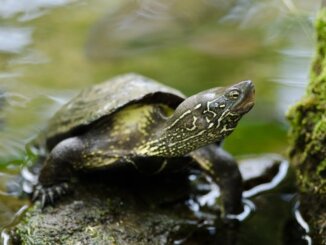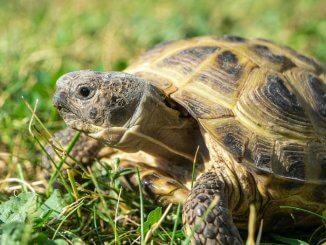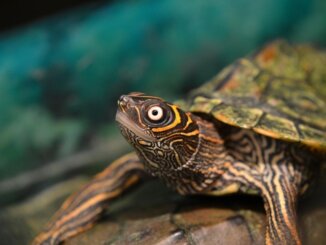The cooter turtle is of the Pseudemys genus, and is native to the rivers of the southeastern US. Cooter turtles are easy to care for, and they make great beginner pets.
There are seven kinds of cooter turtles, and their appearance depends on their species, each with its own unique markings and colorings. In general, cooter turtles have elongated bodies with slightly more flattened shells than other turtles.
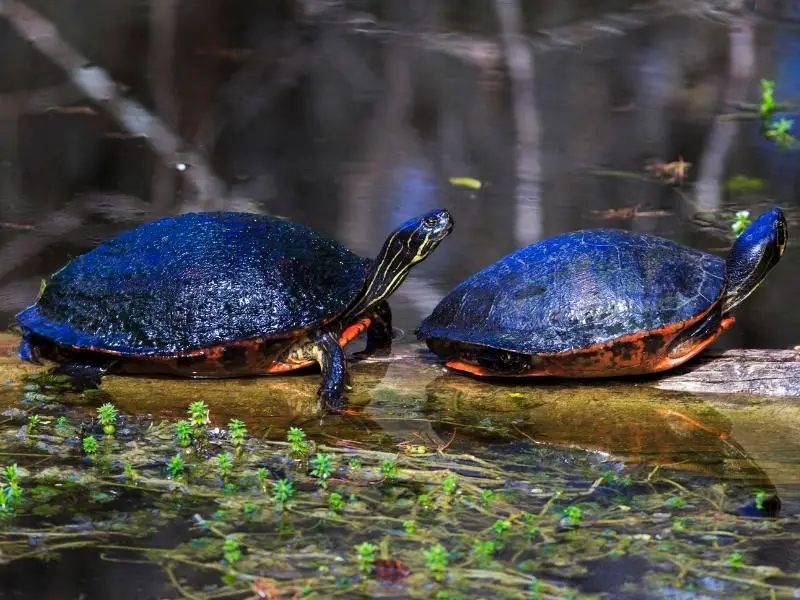
Setting up the correct tank with the right lighting and heating will ensure your cooter turtle is healthy and happy and can live a long life. As a cooter turtle grows it will require a larger tank or an outdoor pond to accommodate the larger size of its shell, and to give the turtle room to bask.
Cooter Turtle Overview
| Common Name: | Cooter turtle |
| Scientific Name: | Pseudemys |
| Natural Habitat: | Originates from the southeastern US. Found in rivers, deltas, and ponds, depending on the species |
| Adult Size: | Females: 10–14 inches
Males: 9–12 inches |
| Average Lifespan: | 20–40 years (depending on the species) |
| Diet: | Omnivorous |
| Housing: | Various tank sizes from 20–30 gallons (juveniles) up to 300 gallons (adults) and large outdoor ponds for bigger varieties |
| Experience Level: | Beginner |
Origin
The cooter turtle (Pseudemys) originates in the southeastern US. These aquatic turtles are found in waterways, rivers, ponds, and wetlands.
The more common species of cooter turtle, such as the river cooter, is commonly found in many waterways and streams in the southeastern US, but some species aren’t normally seen in the wild because they have reached endangered species status.
The Alabama red-bellied cooter turtle (Pseudemys alabamensis) is an endangered species, while other cooter species such as the common river cooter (Pseudemys concinna) has no conservation status.
Appearance and Behavior
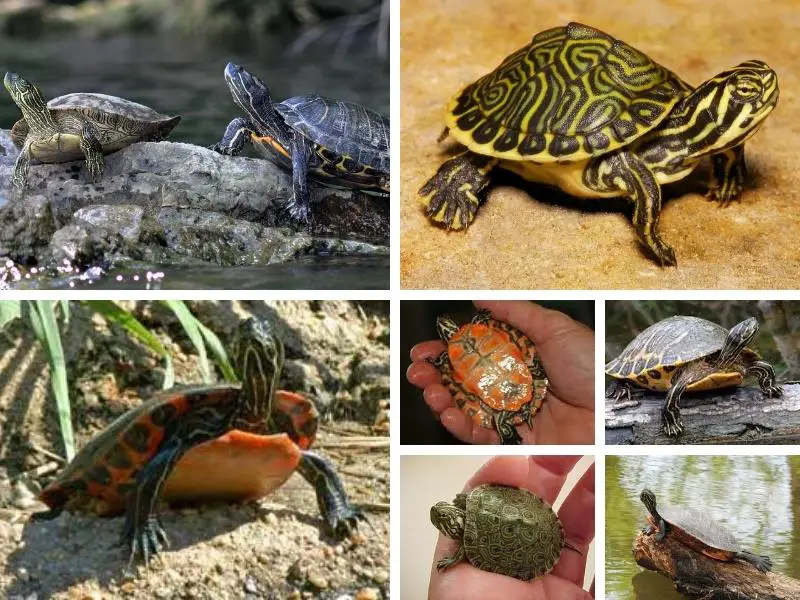
The appearance of cooters depends on their species. It is challenging even for expert herp vets to tell some of the different cooter species apart. The basic differences are as follow:
- River cooter: Elongated shell with yellow, brown, or black markings
- Alabama red-bellied cooter: Shell is dark green to dark brown or black with red to yellow vertical markings
- Florida red-bellied cooter: Dark brown to greenish shell with a reddish underside
- Texas river cooter: Dark green shell with black and yellow patterns that fade with age
- Peninsula cooter: Dark green shell with yellow and green striped skin
- Rio Grande cooter: Olive-colored shell with alternating patches of black and yellow
- Northern red-bellied cooter: Olive shell with red vertical stripes
Male cooters tend to be smaller in size than the females, but their shells are similarly shaped.
Size and Lifespan
Cooter turtles range in size, the largest being the Suwannee cooter at 17 inches in length. The smallest cooter turtle is the river cooter turtle, of which the male measures 9 inches.
Cooter turtles live an average of 20–40 years.
Temperament
Most cooter turtles are docile and can be housed with other turtle species without causing any conflict. However, when it comes to breeding season, the ratio of male to female turtles may cause the turtles to become hostile.
Smaller turtle species should be housed in different enclosures from the larger species to avoid fighting and injuries.
Cooter turtles are prey animals, and there are several larger animals that may eat them such as muskrats, alligators, and even humans (who make turtle soup).
Since the cooter turtle is a prey animal, it instinctively gets stressed by fast movement, loud noises, and by being handled too much.
Housing Cooter Turtles
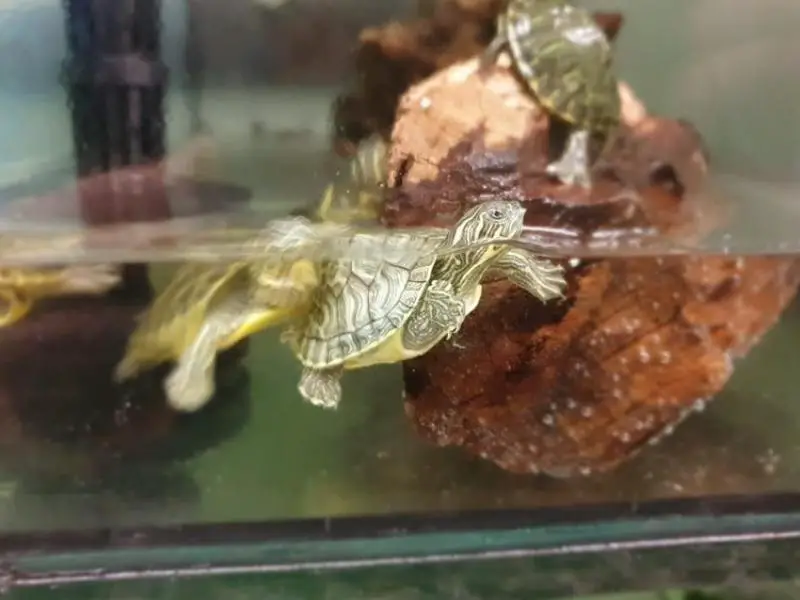
Cooter turtles inhabit river and dam areas where they can enjoy the combination of watery ponds, and sandy areas that they can bask on. To keep cooter turtles in captivity, your enclosure should simulate the turtle’s wild conditions.
This means you need a large volume tank for the watery depths, with a rocky outcropping where a UVB light best simulates basking conditions.
For larger sized or adult cooter turtles, the tank depth should be at least 12 inches, though a deeper tank will aid the adult cooters in swimming, and rising to the basking rocks.
The width of the tank should be at least three times the length of the cooter turtle kept in the tank.
This means the tank size will need to increase as the cooters mature and grow.
Enclosure Size
When the cooter turtle is small, a 20–30 gallon tank is sufficient, but as the turtle matures, a larger tank of as much as 300 gallons capacity per adult is required. In a garden pond, your cooters require similar capacity at minimum.
Smaller cooter species, such as the Rio Grande cooter, grow to less than a foot in length, so a 100-200 gallon tank is sufficient for adults. Single adult male Rio Grande cooters (since they’re smaller than the females) may be quite content in a 75-gallon tank.
Female Rio Grande cooters will thrive in a larger 100–150 gallon tank.
A tank that is at least 47 inches wide and 12 inches high is best for any cooter turtle. The length depends on the dimensions of your space and how much swimming room you want to give the cooter turtles. For more cooters in the same tank, you should double up on all dimensions.
As your cooter turtles mature, they may require a tank with extra height that prevents them from climbing the sides, as their larger size allows them.
Lighting
Use a UVB light in your cooter turtle’s tank to help stimulate their natural vitamin D3 synthesis processes.
If your tank is indoors, be sure to simulate a 12-hour day and night cycle to help your cooter turtle sleep normally. Position the UVB light over the basking area. Use a UV light to clean the tank’s water.
Temperature and Humidity
Use a high quality thermostat and heater to ensure your tank has the right temperature range for your cooters. Maintain a water temperature of 75–80˚F and ensure the area for basking is warm, at 85–90˚F.
Use a heat lamp to maintain and regulate the tank temperature of the basking area, and a water heater for the swimming area.
In a breeding tank or in your cooter’s outdoor breeding pond enclosure, the basking area should maintain a heat of nearly 100˚F to ensure optimal embryonic development of the cooter eggs.
Substrate and Decoration
Cooter turtles don’t require substrate, but you can add large stones or pebbles that they can bask on or forage around. Cleaning the pebbles or stones is easy, and makes tank maintenance almost effortless.
Ensure there is a large enough basking area where the cooter turtles can surface and enjoy some UVB rays from a lamp or the sun. Avoid large rocks that could trap your cooter under water, which could make drowning likely.
Cleaning
Your turtle’s tank or aquarium needs to have an effective filtration system to keep the water clean. Installing a good quality filter will ensure the water is cleaned and filtered of any microbes that aren’t healthy for the cooter turtles.
Use a tank vacuum at least four times every month to clean the bottom of the tank and in between the large bottom stones. Rely on a UV light to help sterilize the tank water, limiting the toxic potential of pathogens that may be present in the water.
With weekly tank water changes, the water nitrate levels are maintained at low levels. Be sure to dechlorinate the tap water before switching out a percentage of the tank water. Basic weekly maintenance and cleaning involves a simple 20% tank water change to help keep the tank clean.
Transfer your cooter turtle to a smaller holding tank when performing a major tank clean, as the sound of the tank vacuum can disrupt and stress the turtle. Water changes are harmless to cooter turtles, though it’s better to remove the turtle first or perform the water change in a corner opposite the turtle so as not to stress the cooter.
Cooter Turtle Care
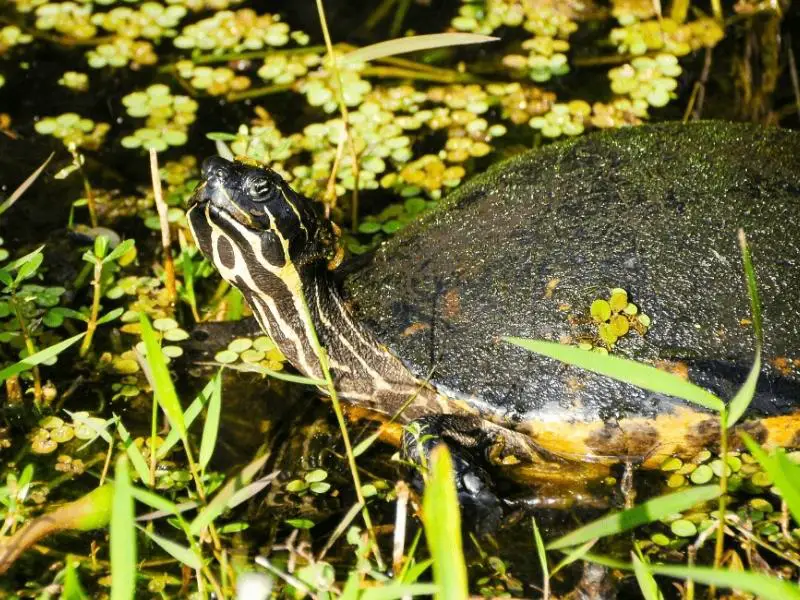
Caring for cooter turtles is fairly easy, and beginners can manage the set-up of an appropriately-sized tank, complete with a basking area, water at the right temperature, and sufficient water filtration. In addition, water changes to balance the nitrate levels, the use of a UV light to eliminate pathogens, and proper feeding are the extent of cooter turtle care.
Food and Water
Cooter turtles have diverse dietary needs that should be appropriately catered to. Most cooter turtles are omnivores. They eat small animals like crustaceans, worms, and fish, and plants including algae, aquatic foliage, and even vegetables like carrots and spinach.
Juvenile cooter turtles prefer protein-rich meals that they can find easily in the wild. In captivity, feed juvenile cooters a similar diet, which includes dead fish and crustaceans. Mature cooter turtles opt for live prey and aquatic vegetation.
Juvenile turtles need daily feeding in small quantities, while adult cooter turtles need feeding three times a week. Feed your cooter an amount of food that it can easily consume in five minutes. Once your cooter turtle has stopped eating the food, remove the excess food to prevent rot and the production of harmful ammonia.
Avoid feeding iceberg lettuce and rotten food to cooter turtles, because these foods may contain toxins which are poisonous to the turtles. Since cooter turtles live in an aquatic environment, you don’t need to provide additional drinking water.
Handling
Most cooter turtles don’t mind being held. Cooter turtles have different temperaments depending on the species. In general, cooter turtles are peaceful, however some wild-raised species, like the Florida cooter, can be aggressive.
The way you handle your cooter turtle depends on its size. Juvenile cooter turtles may be as small as your little finger. Hold these tiny turtles in a pinch grip. Slip your thumb under the turtle’s thoracic shell (belly area), and keep your index and middle fingers positioned on the top shell. Pinch firmly but gently to prevent the juvenile from wiggling from your grasp.
Adult cooter turtles may reach the length of a foot or more. When holding an adult cooter turtle, be sure to place one hand below their thoracic area and keep one hand on the top of their shell to ensure they don’t slip from your grasp.
Never pick the cooter up by the edges of its shell, as this can damage the turtle’s internal organs. Following the above instructions when handling your turtle protects their organs and limits the possibility of dropping them.
A fall can easily crack the turtle’s shell and cause injury. Avoid stressing the cooter turtle with rough handling or loud noises, as this can lead to sickness and possibly death.
Common Health Issues
There are a few common health issues that can cause your cooter turtle to become sick and possibly die.
Dirty tank water can lead to several health issues for the cooter turtle. If the tank water is polluted by ammonia or harmful nitrates, the cooter turtle may sicken and die. Keep tank water clean by following a cleaning routine that involves changing the water weekly, vacuuming leftover food, and using a good quality water filter.
Other health issues include:
- Vitamin A deficiency, which happens when the cooter turtle doesn’t eat enough dark green vegetables. Be sure to feed your turtle leafy greens, and populate the tank with edible aquatic plants like java moss. If your turtle is sick, you may need to add a medicated supplement to the tank water
- Metabolic bone disease and shell rot, which cooter turtles develop due to a lack of vitamin D and calcium. Ensuring there is a UVB light in the tank helps keep your cooter turtle healthy
- Injuries like cuts to the turtle’s skin may also threaten your cooter turtle’s health. Ensure the tank is free from sharp edges that may cut a turtle’s skin. If an injury has occurred, monitor and, if necessary, add medicines such as antibiotics to the tank water
Breeding
Cooter turtles reach breeding age at different rates. Female cooters are mature and ready to breed by six years old, while the male cooter turtle may finally be sexually mature at the age of 13. Juvenile cooter turtles won’t reproduce, and opposite juvenile genders can be kept together without fear that they will breed.
In the wild, once a female cooter turtle has bred with any number of her multiple sexual partners, she will look for sandy soil to dig a nest in. She chooses a nesting place within 100 yards of the river or pond edge.
Breeding happens in spring for most cooter turtles, though a cooter turtle may breed two to six times a year, if the weather is warm enough. On average, cooters lay three clutches of eggs per year. A clutch consists of two to 20 oblong-shaped eggs.
If you wish to breed cooter turtles in captivity, you will need a large outdoor pond surrounded with sand where the female can dig her nest and lay her eggs. A tank is not a suitable place for a cooter to lay her eggs.
To encourage breeding of the cooter turtles, keep the turtles in a ratio of one male cooter to five female cooters. The male cooters can become sexually aggressive, and the female cooter may become stressed by unwanted attention if she isn’t ready to mate.
Ensure parameters of the breeding environment are kept in order to support healthy breeding instincts.
Appropriate temperature changes help cycle the cooters through their natural hormone levels.
In nature, cooters mate as spring begins, so use a cooler temperature (50–60˚F) in your enclosure to trigger a natural hibernation cycle, followed by an increased temperature range of 75–80˚F that mimics normal spring temperatures to trigger the turtles’ sexual readiness.
Once breeding has taken place, be sure to enhance the diet of the female cooters. Because the female cooters need vitamin D3 and calcium, increase their access to leafy greens, crustaceans, and add a calcium supplement to their feed.
Ensure the UVB light is working in the enclosure to create an optimal environment that will aid the cooter females in producing eggs.
Cooter turtle eggs hatch after 90–100 days if the temperature remains at 80–85˚F. The soil should be damp to ensure the eggs don’t dry out, and temperature of the soil determines the sex of the turtles.
Warmer incubation temperatures will produce more female cooter hatchlings while cooler temperatures produce more male cooter hatchlings.
Remove the hatchlings from their original enclosure or pond area once they have hatched because the adult cooters will eat their young.
Choosing and Buying a Cooter Turtle
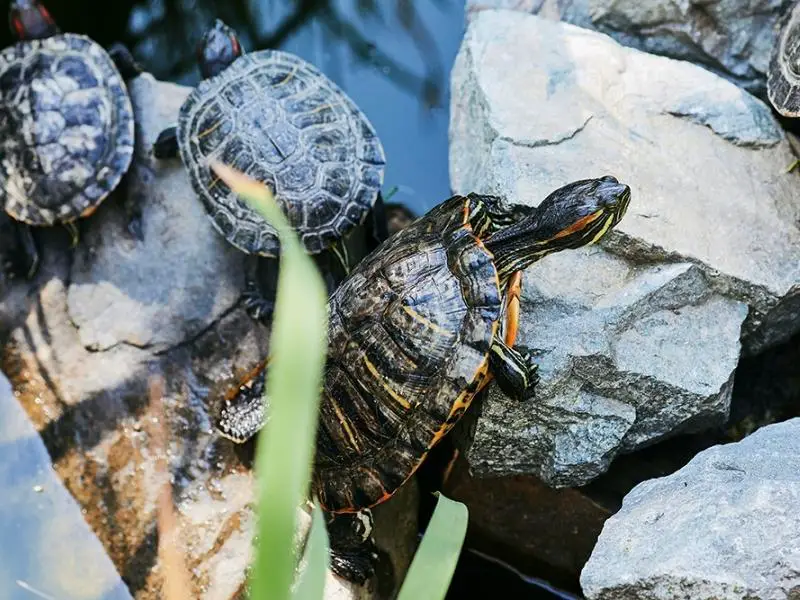
River cooter turtles make great pets because they are docile and curious. Cooter turtles can be obtained from breeders or pet stores without much difficulty, depending on the species.
Avoid taking a cooter turtle from the wild, as you may be taking an endangered species home, which is illegal.
The cost of a cooter turtle ranges from $25–$50 per hatchling. Species like the river cooter turtle and Florida red-bellied cooter turtle are commonly available.
Some of these common, captive-bred species are so abundant in the US pet trade that they are often found in rivers in the southern parts of the US, having escaped or been released from their captive homes.
Be aware that some states in the US require a permit to keep or sell cooter turtles because of the increased risk of salmonellosis, a germ that these pets carry that can easily be passed to humans.
When choosing a cooter for purchase, consider the overall condition of the cooter turtle. If there are signs that the cooter has been injured or is pale in color, then the turtle is sick and may not survive the transition to its new environment.
Poor feeding, improper lighting, and too-small of an enclosure are signs that the cooter may be stressed and is or could easily become sick and die.
For rare cooter species, ask to see a copy of the store’s license, as you wouldn’t want to make an illegal purchase. The store owner should also be able to assist you in legally obtaining a license to keep cooters if required in your area.
If you are unsure if the dealer is reputable, check with your local parks and wildlife society.

